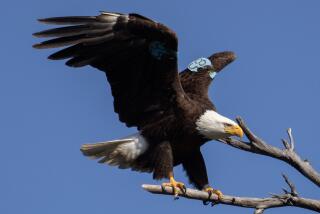ENVIRONMENT WATCH : Regal Eagle
- Share via
The bald eagle as symbol is ubiquitous; on 25-cent coins and dollar bills, in Native American rituals, festooning countless institutional and governmental logos. But in reality the bald eagle has led a much less glorious, indeed a struggling, existence.
There may have been as many as 75,000 of these majestic birds in what is now the United States when Europeans arrived. Although the eagle feeds largely on fish and carrion and is no threat to humans, settlers considered it vermin, to be shot on sight.
By 1940, bird populations were so devastated that Congress passed the Bald Eagle Protection Act, barring possession or sale of any bald eagle, dead or alive, its nests or eggs. Despite the penalties in the act, poaching continued to decimate eagle populations, as did DDT poisoning.
Bald eagles hit bottom, ecologically speaking, in 1963, when researchers counted only 417 breeding pairs. Following passage of the Endangered Species Act in 1973, the eagle was listed as being on the verge of extinction.
But with the 218th anniversary of this nation’s declaration of independence comes the good news that our national bird, after decades of decline, has grown more robust. Researchers counted 15,000 eagles in 1992 and reproduction rates have rebounded to pre-DDT levels. The U.S. Fish and Wildlife Service last week removed the eagle from the endangered species list.
The eagle is not the only success story for the controversial Endangered Species Act, but today, especially, the eagle’s resurgence deserves a special cheer.
More to Read
Sign up for Essential California
The most important California stories and recommendations in your inbox every morning.
You may occasionally receive promotional content from the Los Angeles Times.












